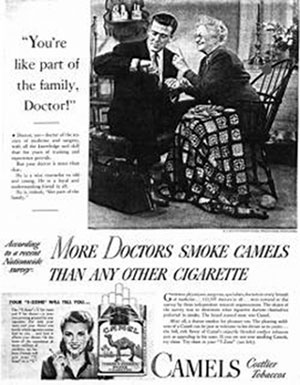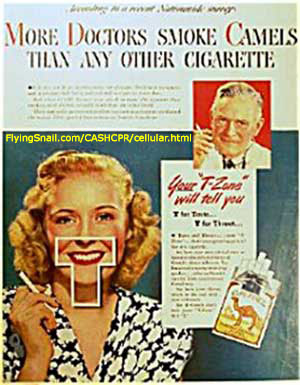CORPORATISM
IN ACTION


CORPORATISM IN ACTION
Camel cigarettes had the largest booth at the American Medical Association's 1948 convention, boasting in its ads that "More doctors smoke Camels than any other cigarette."
Doctors Recommend Smoking Camels
" According to a nationwide survey: More doctors smoke Camels than any other cigarette." (Sound Bite) http://www.old-time.com/commercials/camels.html"Doctors Recommend Phillip Morris" ~ Phillip Morris tobacco products
"Just What the Doctor Ordered" ~ L&M Cigarettes
"More Doctors Smoke Camels than any other Cigarette" ~ Camel cigarettes
Once upon a time, the rich, sweetly pungent smoke of tobacco offered more than dreary old diseases like emphysema and lung cancer. It promised sophistication, sex appeal, even longevity itself. Gosh Darn, Wally! http://www.chickenhead.com/truth/index.html
Cigarette advertisement from the 1940s: http://www.chickenhead.com/truth/1940s.html
Cigarette advertisement from the 1950s: http://www.chickenhead.com/truth/1950s.html
Tobacco Escapes Huge Penalty
By Carol D. Leonnig, Washington Post Staff Writer
Wed Jun 8, 1:00 AM ETAfter eight months of courtroom argument, Justice Department lawyers abruptly upset a landmark civil racketeering case against the tobacco industry yesterday by asking for less than 8 percent of the expected penalty.
As he concluded closing arguments in the six-year-old lawsuit, Justice Department lawyer Stephen D. Brody shocked tobacco company representatives and anti-tobacco activists by announcing that the government will not seek the $130 billion that a government expert had testified was necessary to fund smoking-cessation programs. Instead, Brody said, the Justice Department will ask tobacco companies to pay $10 billion over five years to help millions of Americans quit smoking.
Before it was cut, the cessation program was the most significant financial penalty still available to the government as part of its litigation, which had been the largest civil racketeering and conspiracy case in U.S. history. The government contended that six tobacco companies engaged in a 50-year conspiracy to defraud and addict smokers and then conceal the dangers of cigarettes.
"We were very surprised," said Dan Webb, lawyer for Altria Group's Philip Morris USA and the coordinating attorney in the case. "They've gone down from $130 billion to $10 billion with absolutely no explanation. It's clear the government hasn't thought through what it's doing."
The Justice Department offered little explanation for the figure. Associate Attorney General Robert D. McCallum Jr. and members of the trial team declined to answer questions as the court session ended. In 2001, then-Attorney General John D. Ashcroft tried to settle or shelve the government's racketeering case against the industry before a public outcry forced its revival.
"It feels like a political decision to take into consideration the tobacco companies' financial interest rather than health interests of 45 million addicted smokers," said William V. Corr, director of the Campaign for Tobacco-Free Kids. "The government proved its case, but the levels of funding are a shadow of the cessation treatment program that the government's own expert witness recommended."
Sources and government officials close to the case said the trial lawyers wanted to request $130 billion for smoking-cessation programs but were pressured by leaders in the attorney general's office, particularly McCallum, to make the cut. Arguments within the Justice Department continued behind the scenes through yesterday morning, according to the sources, who spoke on the condition of anonymity because of the controversy over the matter.
When the case began in 2004, the government sought to force the tobacco industry to pay $280 billion in allegedly ill-gotten profits. But in February, a federal appeals court ruled that the administration could not seek that penalty.
Michael Fiore, the government expert who recommended $130 billion for cessation programs, is a medical professor and director of a tobacco research center who chaired the subcommittee on tobacco cessation in the Department of Health and Human Services' Interagency Committee on Smoking and Health.
His testimony was widely considered to represent the sum the government was seeking for a cessation program, though Justice Department lawyers had made no formal demand until yesterday.
The strength of the government's case hinged on a large collection of internal tobacco company documents, many of which were never before made public. The government began its case in September by showing on an oversized projection screen the written memos of tobacco executives and scientists as they described their plans to keep customers in the dark about whether their habit was addictive or dangerous and to encourage young people to smoke.
Facing those same internal documents in another suit,the tobacco industry in 1998 agreed to pay $246 billion to settle a lawsuit filed by states to recover their costs for the medical treatment of smokers.
Justice Department spokeswoman Cynthia Magnuson said the department could ask the court to force the industry to pay more in future years for cessation programs, which include a staffed help line for smokers, treatment programs and possibly free medications. She suggested the penalty was designed to comply with the recent appeals court ruling that such penalties could not be used to punish past fraud. Sources close to the case said the cessation program is either a valid penalty or it's not; the dollar figure should not change that.
"This proposal has been designed to be a forward-looking remedy to prevent and restrain future wrongful conduct consistent with the recent Circuit Court opinion in this case," she said.
U.S. District Judge Gladys Kessler, who is presiding over the case, is expected to decide in the next few months whether the government proved its case of an industry-wide conspiracy and whether to order any penalties against the companies. Among the other remedies the government is still seeking are an industry-funded anti-smoking educational campaign and a court injunction to stop the companies from targeting youth in their marketing.
The government also wants the judge to appoint a court monitor to watch over industry practices and ensure that tobacco companies do not commit fraud in the future. Kessler has repeatedly expressed concern about how such proposals would work.
Defendants in the case include Philip Morris USA; R.J. Reynolds Tobacco Co. and Brown & Williamson, which have merged to form Reynolds American Inc.; British American Tobacco; the Lorillard Tobacco unit of Loew's Corp.; and Vector Group Ltd.'s Liggett Group Inc. They began their closing arguments today.
Anti-smoking advocates assailed the decision as a self-inflicted blow that would help the tobacco companies' bottom line and miss a well-earned chance to help American smokers.
William B. Schultz, a former Justice Department official who oversaw the lawsuit under the Clinton administration, said that "it's disappointing, to say the least, that at the final stages of this litigation they have pulled their punches in such a significant way. This is the loss of a significant opportunity to advance public health. Smoking is the number one preventable disease. It kills 400,000 people a year."
Lead government attorney Sharon Eubanks had summed up the trial early yesterday, saying the government had proved the industry engaged in a "decades-long pattern of . . . misrepresentations, half-truths, deceptions and lies that continue to this day."
Source: http://news.yahoo.com/news?tmpl=story&u=/washpost/20050608/ts_washpost/tobacco_escapes_huge_penalty [click to visit]
INTERESTED IN MORE INFORMATION?
CLICK HERE TO READ: http://www.flyingsnail.com/CASHCPR/cellular.html